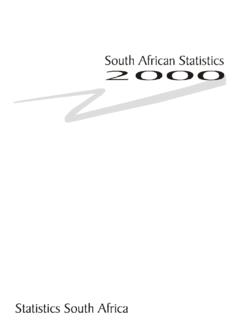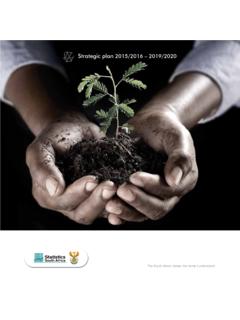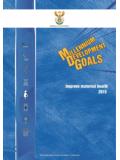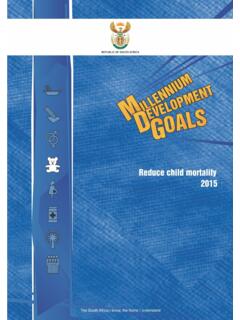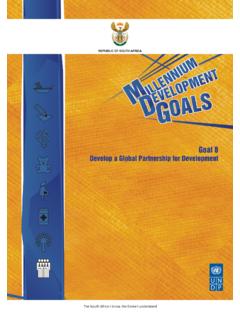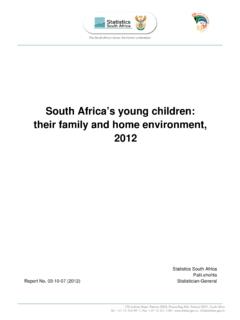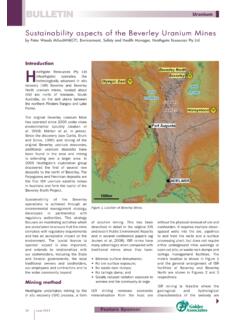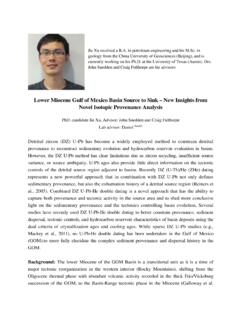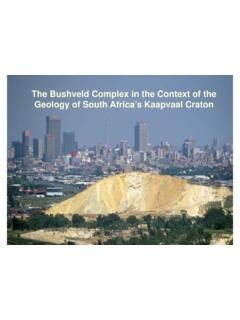Transcription of Published by Statistics South Africa, Private Bag X44 ...
1 Published by Statistics South africa , Private Bag X44, Pretoria 0001 Statistics South africa , 2005 Users may apply or process this data, provided Statistics South africa (Stats SA) is acknowledged as the original source of the data; that it is specified that the application and/or analysis is the result of the user's independent processing of the data; and that neither the basic data nor any reprocessed version or application thereof may be sold or offered for sale in any form whatsoever without prior permission from Stats SA. Natural resource accounts: Energy accounts for South africa , 1995 2000:Discussion document A complete set of Stats SA publications is available at Stats SA Library and the following libraries: National Library of South africa , Pretoria DivisionNational Library of South africa , Cape Town Division Library of Parliament, Cape Town Bloemfontein Public Library Natal Society Library, PietermaritzburgJohannesburg Public Library Eastern Cape Library Services, King William's TownCentral Regional Library, Polokwane Central Reference Library, Nelspruit Central Reference Collection, KimberleyCentral Reference Library, MmabathoThis discussion document is available on the Stats SA website: are available from: Printing and Distribution, Statistics South africa Tel.
2 (012) 310 8044 / 310 8161(012) 310 8161 Fax:(012) 321 7381 Email: Statistics South AfricaiPrefaceThis report contains the natural resource accounts for energy in South africa from 1995 to 2001. The report has been compiled in accordance with the recommendationsof the System of Integrated Environmental and Economic Accounting 2003 (SEEA 2003).The SEEA 2003 defines natural resource accounting as an accounting system that deals with stocks and stocks changes of natural assets, comprising biota (produced or wild), subsoil assets (proven reserves), water and land with their aquatic and terrestrial ecosystems. It is frequently used in the sense of physical accounting as distinguished from monetary (environmental) accounting.
3 This document is for discussion and to obtain comments and/or suggestions from all the relevant stakeholders and users. It will only be made available on the StatisticsSouth africa Energy accounts for South africa , 1995 2001 Statistics South AfricaiiList of abbreviations CO2 Carbon dioxideDMED epartment of Minerals and EnergyGDPG ross Domestic Product GWGiga watt IAEAI nternational Atomic Energy AgencyIEAI nternational Energy AgencyIMFI nternational Monetary FundLPGL iquefied petroleum gas MmtMillion metric tons NEAN ational Energy AgencyNOXN itrogen oxideOECDO rganization for Economic Cooperation and DevelopmentPBMRP ebble bed modular reactor PJPetajouleSEEAS ystem of Integrated Environmental and Economic AccountingUNUnited Nations TWhTerawatt hour TJTerajoulesPVPhotovoltaicSNAS ystem of National Accounts SOXS ulphur oxideEnergy accounts for South africa .
4 1995 2001 Statistics South of abbreviations ..ii1. International Energy supply Energy use table .. 43. South African classifications .. Energy resources .. Coal .. Wind Solar power .. Wave power .. Biomass Nuclear power .. Hydropower .. Sectors concerned with energy use .. The industrial The commercial sector .. The agricultural sector .. The residential sector .. The transport Supply and use tables for energy for South africa ..285. Conclusion ..446. Glossary .. 467. References ..50 Energy accounts for South africa , 1995 2001 Statistics South Africa11. Introduction Natural resource and environmental accounts aim at collecting qualitative and quantitative information on both the state of natural resources and their evolution, within a consistent framework.
5 The general purpose of natural resource accounts is to provide policy-makers with an information base on natural resources and to contribute to the general awareness of the environmental issues at each level of decision-making,and of the general public. Energy accounts are of considerable interest in their own right, especially forcountries heavily involved in oil mining and processing. Also, every economy in theworld depends on the availability of oil and other energy sources. The use of energy iscritical to the economy, because almost all economic activities are connected eitherdirectly or indirectly to the consumption of accounts provide information about the levels of direct energy consumption of industries regarding their production process and Private households.
6 These accountscan also provide information on changes in the energy requirements of particular industries in relation to their output. This shows the macro level impacts of new technologies and eco-efficiency measures and behavioural changes. They are also an indispensable prerequisite for reliable estimates of air emissions related to South African economy can be considered as energy intensive. This is because itis still based on primary extraction and the processing of coal and uranium. SouthAfrica s indigenous energy resource base is dominated by coal, primarily because it is relatively cheap and plentiful. Many of the deposits can be exploited at extremelyfavourable costs and, as a result, a large coal mining industry has developed2.
7 In addition to the extensive use of coal in the domestic economy, large amounts areexported, mainly through the Richards Bay Coal Terminal to European countries and the Far East. Apart from coal, South africa sources energy locally from biomass (such 2 According to the Mineral Accounts for South africa (Report ; 1980 2001) in 2001 therewere 246 years left before coal will be depleted at the current rate of extraction of 223,5 tons a year. Energy accounts for South africa , 1995 2001 Statistics South Africa2as wood and dung)3, natural gas, hydropower, nuclear power, solar power and wind power. South africa has very little oil reserves and therefore, the majority of our crude oil is imported. South africa also has fairly small gas fields, off her South coast, which supply Mossgas.
8 Renewable energy sources, other than biomass, have not yetbeen exploited to the full in South africa . South africa has very large coal and uranium reserves (coal reserves were estimatedat 55 billion tons in 2002 and the estimate of reasonably assured uranium resourceswas 205 000 tons)4; limited reserves of hydropower; a large potential for solar power, especially in the Northern Cape; and considerable potential for wind power in thecoastal aim of this discussion document is to present and discuss the energy accounts for South africa from 1995 to See Residential Sector ( ) for more information on Energy Outlook for South africa : 2002 Energy accounts for South africa , 1995 2001 Statistics South Africa32. International guidelines Energy accounts usually embrace all four types of physical flows: natural resourceextraction (coal, crude oil, natural gas), ecosystem inputs (oxygen combustion),products (energy fuels such as petrol, diesel etc.)
9 And residuals generated by the use of fossil fuels. (Emissions to air and other residuals such as ashes are dealt with separately in the emission accounts). Figure 1 summarises the scope of the energy accounts. Figure 1: Scope of energy accounts in the case of oil Environmental sphere Natural resourcesResidualsEconomic sphereOil miningRefiningEnergy use Source: Integrated Environmental and Economic Accounting: 2003 Physical energy accounts should be constructed in extended supply and use tables. Usually the energy supply and use accounts will include both the monetary as well as the physical units. In the South African energy accounts, we however only used thephysical units, which are converted to terajoules (TJ) to give total energy use and total energy supply, since the monetary values are not easily Energy supply table Supply of products is defined as domestic production plus import of the variousenergy commodities.
10 The two main sources used to obtain data on the supply of energy are production Statistics and foreign trade Statistics . It is important that the nomenclatures of these two sources be absolutely compatible. Both the production Energy accounts for South africa , 1995 2001 Statistics South Africa4and the foreign trade Statistics will normally provide data on the monetary value as measured in basic prices of the energy commodities both produced domestically and imported as well as the corresponding physical quantities thereof. If only monetary values are available, the data can be supplemented with data from the sort of energy balances of the country and made compliant by the International Energy Agency (IEA).
